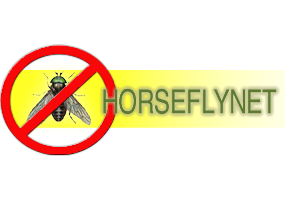-
Those of us at Horse Fly Net® think this is worth reading by trail riders.
It’s that time of year again, and those nasty yellow flies are biting… here are some tips for armoring yourself and your horses against a painful pest.
In Florida, the name “yellow fly” is used to describe about a dozen different species of yellow-bodied biting flies. “Yellow flies” readily attack humans and are usually abundant in Florida with peak annoyance occurring in May and June. “Yellow flies” are in the family known as Tabanidae. All tabanids go through an egg, larva, pupa and adult stage, referred to as “complete metamorphosis,” the same development process that mosquitoes go through. Tabanids lay egg masses containing 50 to several hundred eggs. Most species deposit their eggs around ponds, streams or swamps on overhanging vegetation such as grasses or cattails.
Yellow flies congregate in shaded, humid areas on the edges of forests, rivers and creeks, avoiding large, open, sunny areas. Some species are active in the early morning while other species are more active in the late afternoon.
However, depending upon conditions such as heavy tree canopy, cloudy days or when an animal is moving through an area, yellow flies can become active and bothersome throughout the day. “Yellow flies” prefer to attack man about the head, neck or shoulders, however, any exposed part of the body may be attacked.
Their persistence to obtain a bloodmeal, once a host is found, can make 5 or 6 flies unbearable. Sometimes the use of the old-fashioned fly swatter will give relief by taking out the few flies in an area.
What to do
A trapping method homeowners can use, which does not involve the use of pesticides, is called the “sticky black ball” trap. Basically it is a beach ball, (milk jugs work just as well and are easier to hang) painted black and coated with a sticky substance. The sticky substance is called Tangle-Trap and comes in a spray or liquid applicator. It can be found at local Ace Hardware stores.
These devices are hung from a tree limb using string, in a shaded area, about 4 feet above the ground. Movement of the ball by the wind attracts the flies, thinking it is an animal, they land, get stuck, and die on the ball. Several of these balls will reduce the local adult populations.
You can also create your own “ball” using a milk jug, spray paint it a dark color and apply a sticky substance.
Vegetation management
By removing underbrush around a residence, helps to eliminate resting sites for the flies and increases light levels making the area less attractive.Bite and sting relief
Here is a general purpose sting relief for yellow flies. It is also helpful for mosquito, chigger and jellyfish bites.
1 tsp. baking soda
1/3 cup ammonia (Windex is mostly ammonia)
1/3 tsp. papain (meat tenderizer)
1 crushed aspirin
Mix thoroughly and store in refrigerator (be sure to label container). When needed, shake well and apply with cotton swab, and rub briskly.Personal protective measures include the use of repellants containing DEET (diethyl metatoluamide) applied to exposed skin. Wearing physical barriers such as a head net, long sleeve shirts and long pants are effective protection if you must be out in areas where “yellow fly” populations are high. Permethrin containing products labeled for application to clothing only, can also be effective in repelling and killing “yellow flies”. Thankfully, “yellow fly” season is relatively short, one maybe two months, and then mosquitoes become our major pest.
Information courtesy South Walton Mosquito Control.
On a recent trail ride I found that using a Croup Cover™ helped part of my horse but his face and neck need to be rubbed with “Wipe” a Farnum product that can be rubbed into the hair with a mit.
K. Hubley Horse Fly Net® copy right 2012
Yellow Flies are Back
Call Us at (910) 725-2115 or Email Us at info@horseflynet.com
Horse Fly Net
This see-through breathable screen will last for years. It is made of polyester vinyl coated and heat sealed on the edges with brass grommets about every foot. It has no chemicals added. Our HorseFlyNets only cost approximately $2.00 a square foot for smaller sizes and less for larger. Our product is woven and manufactured in the USA.
HorseFlyNet®
Southern Pines, NC
(910) 725-2115
info@horseflynet.com

